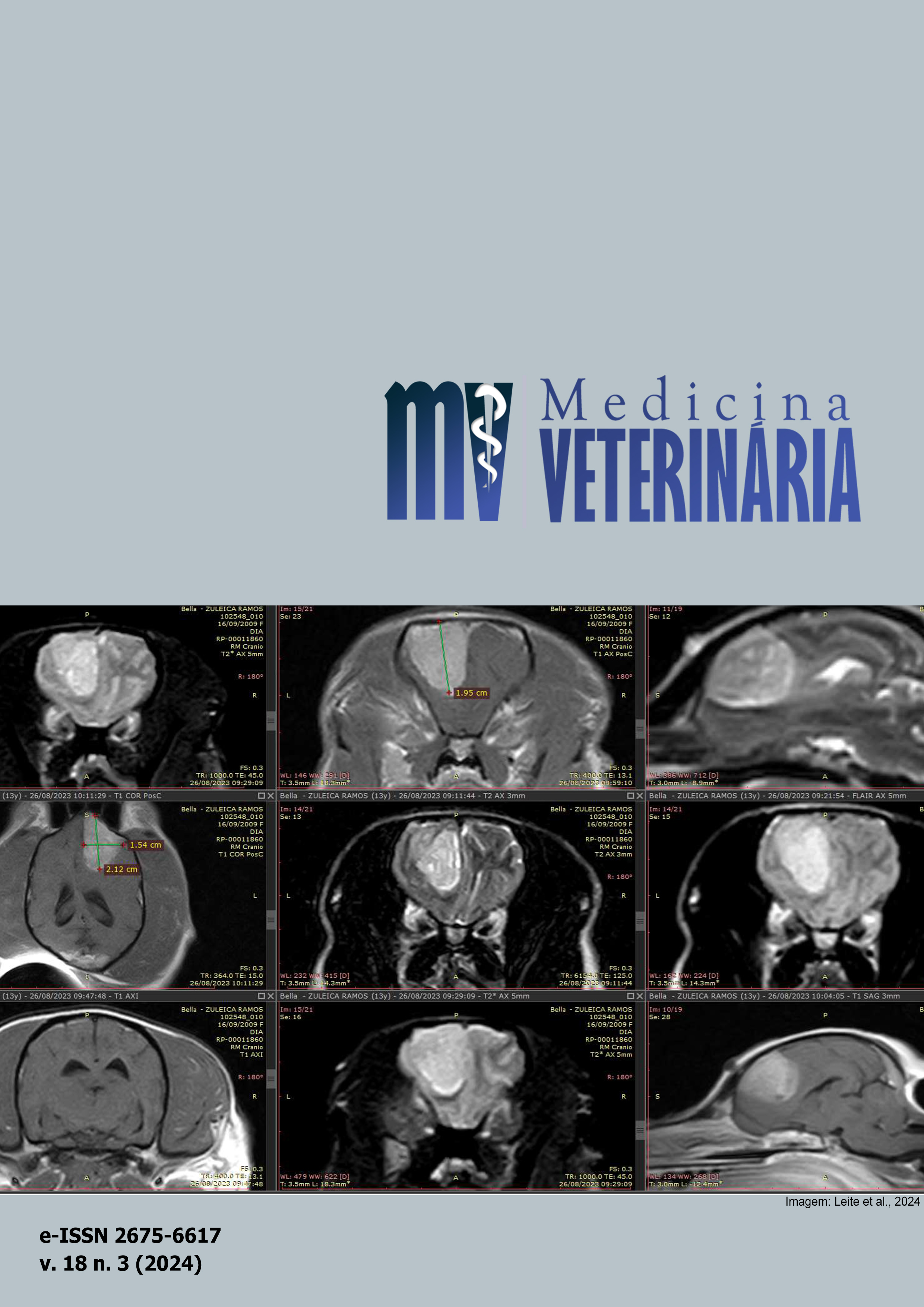Partial vestibulovaginectomy associated with neouretrostomy for the treatment of vaginal fibroleiomyoma: case report
DOI:
https://doi.org/10.26605/medvet-v18n3-6188Keywords:
Surgery, episiotomy, neoplasia, urogenitalAbstract
Neoplasms of the tubular reproductive tract in female dogs represent a total of 2-3% of canine neoplasms, of which 85-90% occur in the vagina and vulva. Fibroleiomyoma is a benign tumor, generally non-invasive, non-metastatic and slow-growing. The choice of surgical approach for treatment will depend on the degree of involvement of adjacent structures and the size of the neoformation. Therefore, the objective is to report the clinical and pathological aspects of fibroleiomyoma and to describe the partial vestibulovaginectomy (PVV) associated with neourethrostomy in a female dog. For diagnosis, tumor delimitation, and surgical planning, computed tomography was performed. The surgery was performed in two stages, the first of which consisted of performing a median retroumbilical celiotomy to free the uterine stump of adhesions. The second consisted of performing an episiotomy to expose the anatomical structures, tissue divulsion, retroflexion of the vagina, ligation, and removal of the entire portion affected by the neoplasm. It was necessary to perform a neourethrostomy, since the neoformation involved the urethral ostium. The main postoperative complications observed were urinary incontinence and uremic dermatitis near the new urethral ostium. Partial vestibulovaginectomy associated with neourethrostomy is an effective and feasible approach in the treatment of extensive neoplasms of the genitourinary tract in female dogs.Downloads
References
Bilbrey, S.A. et al. Vulvovaginectomy and perineal urethrostomy for neoplasms of the vulva and vagina. Veterinary Surgery, 18(6): 450–453, 1989.
Cooper, B.J.; Valentine, B.A. Tumors of muscle. In: Meuten, D.J. Tumors in domestic animals. Iowa: Blackwell, 2002. p.319–364.
Corgozinho, K.B. et al. Catheter-induced urethral trauma in cats with urethral obstruction. Journal of Feline Medicine and Surgery, 9: 481-486, 2007.
Folk, C.A.; Lux, C.N.; DeGroot, W. Ovariohysterectomy and partial vaginectomy for treatment of cervicovaginitis in a dog. Case Reports in Veterinary Medicine, 2019(1): 1-5, 2019.
Hill, T.P.; Lobetti, R.G.; Schulman, M.L. Vulvovaginectomy and neo-urethrostomy for treatment of haemangiosarcoma of the vulva and vagina. Journal of South Africa Veterinary Association, 71(4): 256–259, 2000.
Igna, C. et al. Subtotal gaginectomy as a treatment for Vaginal tumours in two bitches. Bulletin of University of Agricultural Sciences and Veterinary Medicine, 73(1): 1-6, 2016.
Johnston, S.D.; Kustritz, M.V.R.; Olson, P.N.S. Disorders of the canine vagina, vestibule, and vulva. In: Kersey, R. Canine and feline theriogenology. Philadelphia: Saunders, 2001. p.225–242.
Klein, M.K. Tumors of the female reproductive system. In: Withrow, S.J. Small animal clinical oncology, 4th ed. San Luis: Saunders, 2007. p.610-618.
Lima, G.; Andreussi, P.A.T. Leiomioma vaginal e uterino em cadelas: Relato de caso. Pubvet, 13(03): 1-5, 2019.
MacLachlan, N.J.; Kennedy, P.C. Tumor of the genital systems. In: Meuten, D.J. Tumors in domestic animals. Iowa: Blackwell, 2002. p.547-573.
Menegassi, C.C. et al., Aspectos clínicos, cirúrgicos, histológicos e pós-operatórios de oito cadelas com leiomioma vaginal. Arquivo Brasileiro de Medicina Veterinária e Zootecnia, 68(2): 307-312, 2016.
Nelissen, P.; White, R.A. Subtotal vaginectomy for management of extensive vaginal disease in 11 dogs. Veterinary Surgery, 41: 495-500, 2012.
Ogden, J.A. et al. Outcomes associated with vaginectomy and vulvovaginectomy in 21 dogs. Veterinary Surgery, 49: 1132–1143, 2020.
Salomon J.F.; Deneuche A.; Viguier E. Vaginectomy and urethroplasty as a treatment for non-pedunculated vaginal tumours in four bitches. Journal of Small Animal Practice. 45:157–61. 2004.
Santos, D.L. Chaves J.F.; Souto, M.P.; Lima, G.M.M.; de Sousa Siqueira, J.; de Sousa, S.S.; Silva, G.S.; Moura, M.A.O.; Ribas, P.S.; Schwanke, K.; Bezerra Junior, P.S.; Teixeira, P.P.M. Episiectomy and partial vaginectomy with urethroplasty for excision of vulvar mast cell tumour in a female dog. Veterinární Medicína, 66(3):121–6, 2021.
Schlafer, D.H.; Miller, R.B. Female genital system. In: Jubb, K.V.F.; Kennedy, J.P.; Palmer, N.C. Pathology of domestic animals. 5th ed. Philadelphia: Elsevier, 2007. p.429-564.
Tivers, M.; Baines, S. Surgical diseases of the female genital tract 2. Vagina and external genitalia. Companion Animal Practice, 32(8): 362-369, 2010.
Yoon, H.Y.; Mann, E.A. Bilateral pubic and ischial osteotomy for surgical management of caudal colonic and rectal masses in six dogs and a cat. Journal of American Veterinary Medical Association, 232(7): 1016-1020, 2008.
Zambelli, D., et al. Partial Vaginectomy, Complete Vaginectomy, Partial Vestibule-Vaginectomy, Vulvo-Vestibule-Vaginectomy and Vulvo-Vestibulectomy: Different Surgical Procedure in Order to Better Approach Vaginal Diseases. Animals, 12(2): 196, 2022.
Downloads
Published
How to Cite
Issue
Section
License
Copyright (c) 2024 Tainara Micaele Bezerra Peixoto, Thais Furtado de Almeida Santos, Gabriela Pires Porto, Luiza Fiuza Gomes Carvalho, Ademila Soares Fernandes, Flávia Peixoto de Castro, Luisa Machado Duque, Jordana Brites Jeronimo, André Lacerda de Abreu Oliveira

This work is licensed under a Creative Commons Attribution-NonCommercial-ShareAlike 4.0 International License.
A Revista de Medicina Veterinária permite que o autor retenha os direitos de publicação sem restrições, utilizando para tal a licença Creative Commons CC BY-NC-SA 4.0.
De acordo com os termos seguintes:
Atribuição — Você deve dar o crédito apropriado, prover um link para a licença e indicar se mudanças foram feitas. Você deve fazê-lo em qualquer circunstância razoável, mas de nenhuma maneira que sugira que o licenciante apoia você ou o seu uso.
NãoComercial — Você não pode usar o material para fins comerciais.
CompartilhaIgual — Se você remixar, transformar, ou criar a partir do material, tem de distribuir as suas contribuições sob a mesma licença que o original.
Sem restrições adicionais — Você não pode aplicar termos jurídicos ou medidas de caráter tecnológico que restrinjam legalmente outros de fazerem algo que a licença permita.







